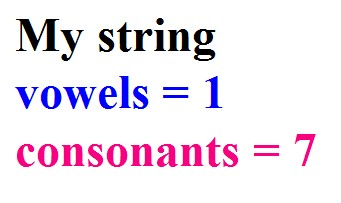- On
- By
- 2 Comments
- Categories: Alphabet
Python program to count vowels or consonants of the given string
Python program to count vowels or consonants of the given string
In this article, we will discuss the concept of the Python program to count vowels or consonants of the given string
In this post, we are going to learn how to count the vowels and consonants in the given string in Python programming language

Python code to count the vowels and consonants using for loop
The program allows the user to enter a string thereafter It counts the vowels and consonants of the given string using for loop in Python language
Program 1
#Python program to count vowel or consonant of the given string
str=input("Please enter a string as you wish: ");
vowels=0
consonants=0
for i in str:
if(i == 'a'or i == 'e'or i == 'i'or i == 'o'or i == 'u' or
i == 'A'or i == 'E'or i == 'I'or i == 'O'or i == 'U' ):
vowels=vowels+1;#vowel counter is incremented by 1
else:
consonants=consonants+1;
#consonant counter is incremented by 1
print("The number of vowels:",vowels);
print("\nThe number of consonant:",consonants);
When the above program is executed, it produces the following result
Please enter a string as you wish: python The number of vowels: 1 The number of consonants: 5
Approach
- Declare and initialize two integer counter variable as int vowels=0 and consonants=0;
- The user asked to enter a string to count vowels and consonants
- A for-loop is used to count total vowels and consonants of the given string
- Use an if statement to test vowel if the test expression is true, vowels become vowels + 1(vowels=vowels+1)
- When the if-statement is false, control moves to else part and executes else part statements
- Finally, the program displays the number of vowels and consonants of the given string.
Python code to count the vowels and consonants using for loop – strlen() function
The program allows the user to enter a string thereafter It counts the vowels and consonants of the given string using strlen() function in Python language
Program 2
#Python program to count vowel or consonant of the given string
str=input("Please enter a string as you wish: ");
vowels=0
consonants=0
str.lower()#call the lower function to avoid upper case letter
for i in str:
if(i == 'a'or i == 'e'or i == 'i'or i == 'o'or i == 'u' ):
vowels=vowels+1;
else:
consonants=consonants+1;
print("The number of vowels:",vowels);
print("\nThe number of consonant:",consonants);
When the above program is executed, it produces the following result
Please enter a string as you wish: Python language The number of vowels: 5 The number of consonants: 10
Approach
- Declare and initialize two integer counter variable as int vowels=0 and consonants=0;
- The user asked to enter a string to count vowels and consonants
- call the str.lower() string function to change upper case lettersto lower case letters
- A for-loop is used to count total vowels and consonants of the given string using the vowels and consonants variables
- Use an if statement to test vowel if the test expression is true, vowels become vowels + 1(vowels=vowels+1)
- When the if-statement is false, control moves to else part and executes else part statements
- Finally, the program displays the number of vowels and consonants of the given string.
Suggested for you
if statements in Python
Similar post
C code to check whether the Alphabet is vowel or consonant
C++ code to check whether the Alphabet is vowel or consonant
Python code to check whether the Alphabet is vowel or consonant
Java code to check whether the Alphabet is vowel or consonant
Java program to count vowels and consonants in a string
C++ program to count vowels and consonants in a string
C program to count vowels and consonants in a string
2 Comments
Melissa March 15, 2021 at 2:09 pm
I believe the code is wrong because python is counting the white space as well. For instance, in your example: Python language: there are 9 consonants not 10, but it is counting all non vowels, including white space. You are also not accounting for the fact that there may be integers in the string, your code would count all non vowels as consonants.
Karmehavannan March 16, 2021 at 11:19 am
i consider your suggestion
suhani jha April 15, 2022 at 9:50 am
invalid syntax
sobharani_ballavarapu June 18, 2022 at 4:20 am
string_s = input() #Good Morning
vowels = 0
consonante = 0
for i in string_s:
if (i == ‘a’) or (i == ‘e’) or (i == ‘i’) or (i == ‘o’) or (i == ‘u’) or (i == ‘A’) or (i == ‘E’) or (i == ‘I’) or (i == ‘O’) or (i == ‘U’):
vowels += 1
else:
if i != ‘ ‘ and i.isdigit() == False:
consonante += 1
print(vowels)
print(consonante)